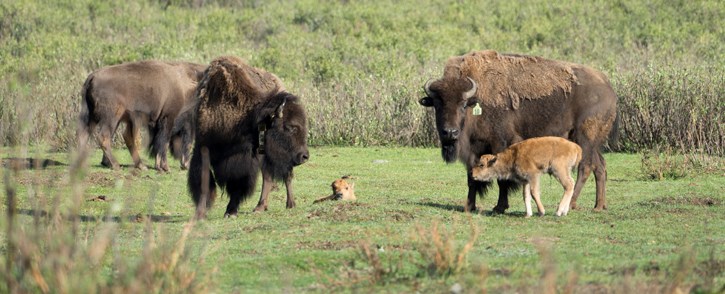BANFF – One of three bison calves born last year in Banff’s backcountry has died in the wild.
It’s unknown whether the calf was preyed upon, died in an accident such as crossing a river for example, or of natural causes.
Parks Canada officials say they lost track of the young animal about three months after it was born, but couldn’t confirm until more recently that it was no longer with its mother when staff got a better visual of the herd.
Karsten Heuer, the project manager for the bison reintroduction program, said the death of the calf is “not such a sad thing” in some respects.
“If you think about what we’re really trying to do here with reintroducing the ecological processes, this is a measure of success. That animal would have fed the ecosystem, would have fed a whole suite of scavengers,” Heuer told Banff town council on Monday (Feb. 10).
“This is the first bison to die in Banff National Park as far as we know in over 150 years – and that’s a significant milestone.”
The $6.4 million bison reintroduction project involved bringing 16 plains bison from a disease-free population at Elk Island National Park to Banff National Park in February 2017 – the first time bison were in Banff’s backcountry in more than 150 years.
For the first 16 months, bison were held in a fenced pasture in the Panther River Valley in an attempt to anchor them to their new home before their release into the greater 1,200-square-kilometre reintroduction zone in July 2018.
There are currently 36 animals in the herd, potentially growing to as many as 300 by 2031.
In the first year, 10 calves were born and another 10 the following year, all in the fenced pasture.
“Over the last year we just had three calves born to our knowledge once they were out in the wild,” Heuer said.
“That was partly a function that we released them during the previous breeding season. It was a little bit chaotic and everybody wasn’t hooking up like they probably should that previous year.”
Since their release from the pasture, the bison have consistently explored areas to the north in the Red Deer River Valley and to the east in the Panther River Valley, including high elevations in summer.
“When we first released them at the beginning, there was a bit of chaos and we actually lost a couple of bulls right off the get-go that dispersed outside the park,” Heuer said, referring to one bull Parks Canada shot because smoky conditions at the time made it difficult to relocate him, as well as two others that were relocated.
“The majority of the herd in the initial months stayed in the Panther Valley; then they actually came back to the soft release pasture several times, and then over the last year they went into the Red Deer Valley and explored,” he added.
“Just over the last few months they went back into the Panther and right back to the soft release pasture, so until this time we were kind of a little bit concerned that they were always exploring and not really tying into the home range.”
The fact that the bison are spending time in the core of the reintroduction zone by the former soft release pasture is a good signal they are anchoring to their new home, according to Heuer.
“They’re actually returning after doing some exploring and actually repeating some patterns,” he said.
“That gives us an indication that maybe they are developing this as their new home range.”
At the conclusion of the pilot project in 2022, Parks Canada will determine whether longer-term bison reintroduction is feasible.
If the answer is yes, Parks Canada will do up a bison management plan. If the answer is no, the animals will be removed.
“Personally, at this stage in the project I’d say it’s going really well,” Heuer said, noting Parks Canada’s primary definition of success is ecological restoration, while also recognizing the important cultural connections with First Nations and Canadians across the country.
“They’re back in a place where they need to be, but where they haven’t been for over 150 years.”
Following Monday’s presentation to council, Mayor Karen Sorensen thanked Heuer and Parks Canada for all their dedicated work on this project.
“It really is an amazing and inspiring story,” she said.





